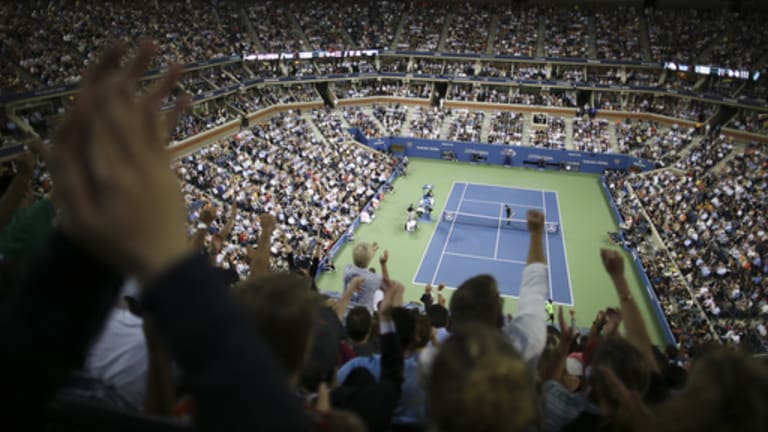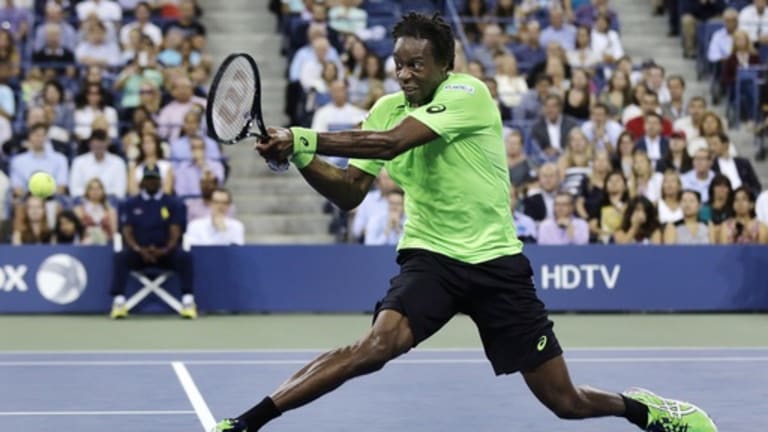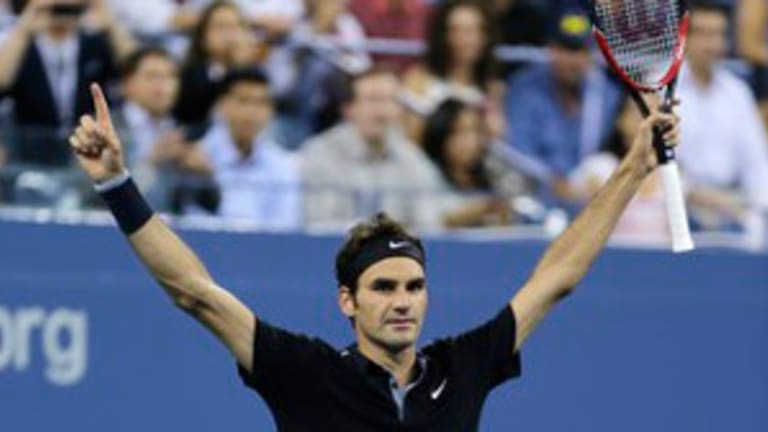No. 8: The Roger Resurgence
By Steve Tignor Dec 03, 2014Who is Diego Dedura-Palomero? Meet Germany’s latest teenage star
By Emma Storey Apr 17, 2025Rafael Nadal to be honored with 'exceptional' tribute on opening day of Roland Garros
By Associated Press Apr 17, 2025Mirra Andreeva belts 'Happy Birthday' song to coach Conchita Martinez in Stuttgart
By Baseline Staff Apr 16, 2025Ben Shelton uses altitude to his advantage, joins Alexander Zverev in Munich quarterfinals
By TENNIS.com Apr 16, 2025Iga Swiatek in Stuttgart: From clay court to carpool karaoke!
By Franziska Bruells Apr 16, 2025Thorne taps Ben Shelton to launch new on-the-go performance line
By Stephanie Livaudais Apr 16, 2025Lois Boisson had the perfect response to Harriet Dart deodorant controversy
By Baseline Staff Apr 16, 2025Dominic Thiem ‘loves’ watching Jakub Mensik and Joao Fonseca
By Baseline Staff Apr 16, 2025Ben Shelton: European football's newest superfan? Lefty making most of Munich debut
By Emma Storey Apr 15, 2025No. 8: The Roger Resurgence
In our eighth-best match of 2014, Federer summed up his season wi
Published Dec 03, 2014
Advertising
Why does Roger Federer keep playing? For nights like this one. He may have been sharper on other days in 2014, but no match was as representative of his 2014 resurgence as his 4-6, 3-6, 6-4, 7-5, 6-2 win over Gael Monfils in the U.S. Open quarterfinals.
It’s safe to say that no match was as loud, either. The fabled, but often distracted, New York night crowd “clamped down” on this one, as Federer put it, and “really made it special.” In 30 years at the Open, the only time I can remember the atmosphere being as electric was for Andre Agassi’s late-career epics a decade ago. Agassi described the Ashe audience, in moments like these, as sounding like a cross between a “jet engine and a giant heartbeat.” That’s pretty much the way it felt for Federer-La Monf, with the love flowing in Federer’s direction. He said later that the support helped him believe that he could come back from two sets, and two match points, down.
Federer needed all the belief he could get, because this looked like it was going to be Monfils’ night, and maybe even his tournament. He squandered a big lead, and went away completely in the fifth set, but it was also one of the great performances of his year. It was enough to make many of us wonder if the 28-year-old, despite his many flaws, has a major title or two in his future after all.
For now, here’s a look at the match, TENNIS.com’s eighth-best of 2014, as it played out into the wee hours of September 5.

No. 8: The Roger Resurgence
© AP
Advertising
—I wrote at the top that this win was a good representation of Federer’s season overall. One big reason was the way he played the match. Through the year, with help from new coach Stefan Edberg, Federer had tried to get to the net more often, to make it an integral part of his game rather than just a change of pace. Against Monfils he came in 74 times and won 57 of those points. Yet Federer said those numbers were deceiving; part of the reason they were so high is that Monfils is fast enough to track down his biggest approach shots and force him to hit a volley.
“Today I don’t think I was able to come in enough,” Federer said afterward, “because I was just not hitting the ball well enough off the baseline.”
That’s especially true in the early going. You can see in this video that Federer is the aggressor early, but he's also the one falling further and further behind. He eventually turns it around because of the way he volleys, which is different and better than he had ever volleyed in his career. This is what I wrote at the time:
“Federer won this one at the net not because of the number of times he came in, but because of the way he dug and fought when he was up there. Often in the past he has run through his volleys, happy to rely on his hands rather than getting his legs to do the dirty work. That has improved since he began to work with Stefan Edberg, but tonight, finally, Federer looked like a tougher volleyer. He took some dipping Monfils passing shots and turned them into his own winners.”
—On the other side of the net, Monfils is in full leap from the start. He leaps too soon, in fact, on one floating Federer shot and ends up watching it sail long. But a little later, he’s there to put an overhead away from five feet in the air. You don’t see it much in these highlights, but he was able to push Federer back; through the first two sets, the match reminded me a lot of Federer’s loss to Juan Martin del Potro here in the 2009 final. Monfils is a step quicker everywhere—from the baseline, where he takes a Federer forehand and rifles a bigger one past him; and at the net, where he wins the early cat-and-mouse exchanges. He finishes the second set with just four unforced errors. By then, he had won over at least one fan of the 23,000 in Ashe: NBA star Kevin Garnett was loving La Monf's moves.

No. 8: The Roger Resurgence
© AP
Advertising
—The change comes, slowly, during the third set. Federer breaks to open, but Monfils breaks back. Then Federer begins to take over the net, and win those cat-and-mouse rallies. This time it’s also Federer who’s the cleaner player: He finishes the third set with one unforced error.
—And he begins the fourth set with one of the loudest “Come on!”s of his career, after he breaks at 1-1. Again, though, Federer can’t sustain it, and he follows it up with one of the angriest net smacks of his career when Monfils breaks him back—New York really does have a way of putting you on edge. For the next few games, the Frenchman has the upper hand; Monfils’ grunts, and his chatter, get louder as a suddenly reeling Federer edges closer to defeat.
—Federer reels all the way to the brink: Two match points for Monfils at 4-5 in the fourth. Here, though, we see another way that this match was a microcosm of Federer’s season. In the past, he has often been the one who has lost from match point up; in 2014, he came back from match point down to win on three occasions. This was the first of them. We only see one of those points in this clip, and we don’t linger long enough to hear the crowd, but it was a deafening moment of tennis.
Federer makes a first serve, Monfils puts the return back deep. With the next three shots, though the match changes for good: Federer hits a strong forehand into the corner, Monfils backs up too far and rolls a forehand short, which Federer pounces on for a putaway. Monfils had done a good job of not backing too far off the baseline for much of the match; here, one point from winning, he couldn’t help himself.
—After that, Monfils double-faulted twice in the next game, lost the fourth set, and let it slip away quickly in the fifth. This one would likely rate higher on the year-end list if the fifth set had been at all competitive.
“You know, it’s tough to handle it,” Monfils said of losing the fourth. “I think I was down for five minutes. Roger just jumped on me.”
Still, it had been a night to remember for Monfils. Sipping Coke on the sidelines and chanting in his own private language, he had been Federer’s equal in entertainment value, and he said he had felt at home in New York. It also may have been a night to build on for him. Two months later, Monfils would straight set a stiff-backed Federer in Davis Cup, and afterward he would cite this match as having given him the confidence to do it. Could this loss be the start of the Age of Monfils? It’s a nice thought, anyway.
Asked what he would tell his kids about the match, Monfils said in his quietly philosophical way, “I’ll tell them Dad had a very good opportunity, and he did well.”

No. 8: The Roger Resurgence
© AP
Advertising
—“I felt very warm support for me,” Federer said, “wanting me to go out fighting and believing I could turn this around, because that’s the feeling the crowd gave me. I think when the crowd gives you that, and there were thousands in the stadium, it grows your belief. I mean, New Yorkers, there is nobody like New Yorkers.”
(A reporter told Monfils that he believed the crowd had been equally supportive of both players. He asked him whether he agreed. “Not really,” Monfils said.)
In the end, Federer won because he wouldn’t stop looking for a solution. Monfils understood that better than anyone.
“He started chipping very low,” Monfils said. “I think I handled it good. So then he stick with longer points. It was 50-50, and then he try to come to the net very often. It was a bit better for him. Then he suddenly start to mix everything. That’s why he’s the greatest player, because he can do everything.”
—Two days later, Federer couldn’t do much of anything against Marin Cilic in the semis. But that was also representative of his year: Federer won the most matches on tour in 2014, but he couldn’t go all the way at a major. Yet moments like these must have made the effort feel worthwhile. Who wouldn't, at any age, want to be at the center of a "giant heartbeat," 23,000-people strong?
Twice on Ashe Federer has lost to Novak Djokovic from match point up. So what did he do when he was match point down, when all of his strategic shifts seemingly had gone for nought? He made both his first serves. On the first point, he hit a full-cut swing volley and watched, imagining the worst, as a Monfils backhand pass sailed long. On the second point, he drilled a forehand winner that detonated the stadium.
With his back to the wall, with nothing left to try, telling himself it was “the last point, man,” Federer had gone back to what comes naturally. No tennis player has ever been better at that.
**No. 1: Djokovic d. Federer at Wimbledon
No. 2: Sharapova d. Halep at Roland Garros
No. 3: Kvitova d. V. Williams at Wimbledon
No. 4: S. Williams d. Wozniacki at WTA Finals
No. 5: Wawrinka d. Djokovic at Australian Open
No. 6: Murray d. Robredo at Valencia
No. 7: Federer d. Wawrinka at ATP World Tour Finals
No. 8: Federer d. Monfils at U.S. Open
No. 9: Kvitova d. Kerber at Fed Cup
No. 10: Nishikori d. Ferrer at Madrid**